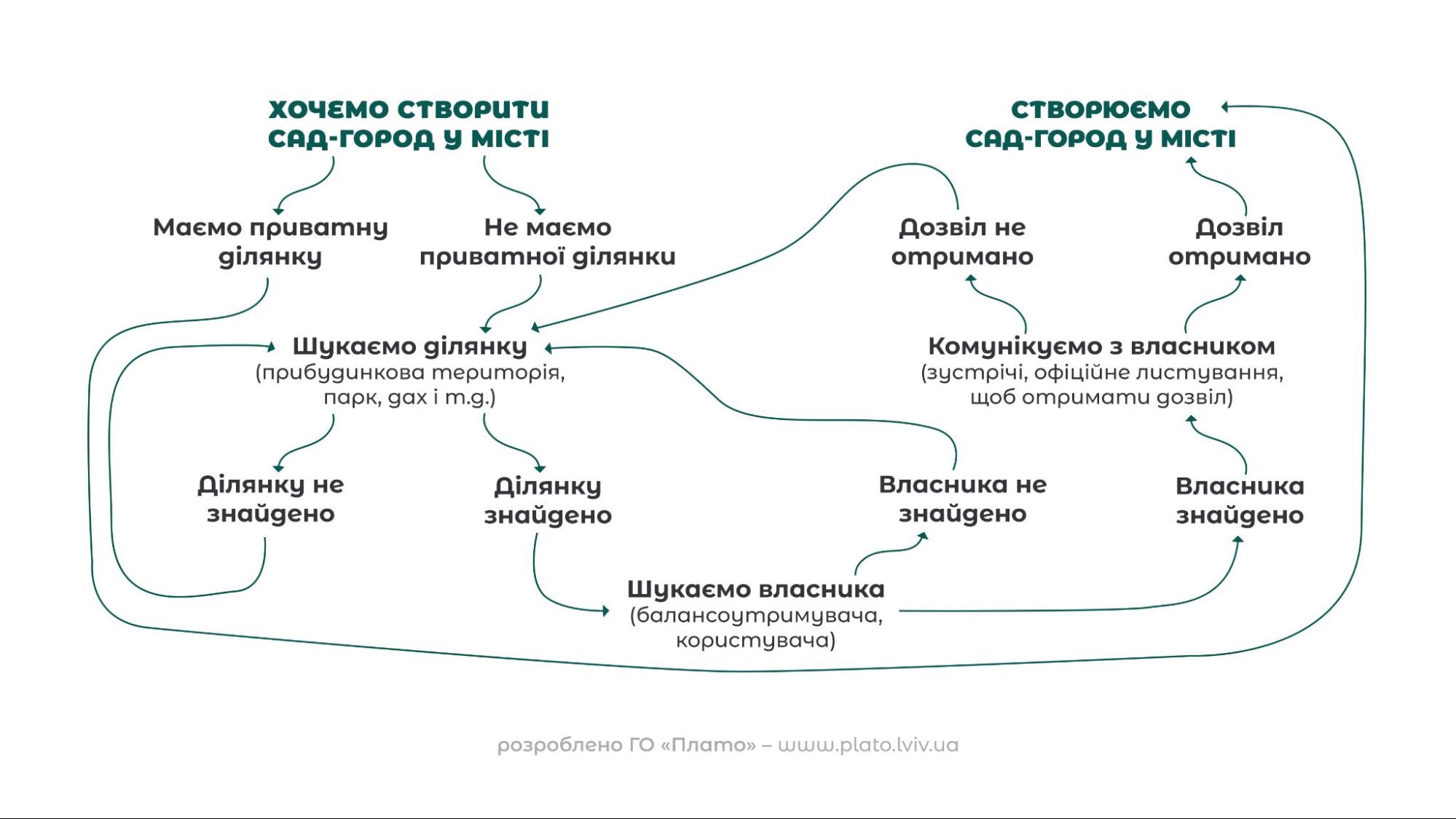To plant or not to plant: how to garden in the city and not break law
Urban gardens are an ecological and helpful solution, especially during a full-scale war. But how to do everything right from the point of view of the letter of the law? We asked the experts.

What is the problem?
Consciously or unknowingly, some Ukrainians became partisans long before the war with russia and continue to be so today. But not ordinary, but green partisans — participants of a grassroots, spontaneous, and by its nature protest movement connected with the realization of one's own right to the city. Representatives of this movement popularize the idea of cultivating land that is not their property, thereby expressing disagreement with the unfair distribution of food resources or urban space. Mostly, this is how the vegetable gardens we see today on the streets of Dnipro, Kyiv, Odesa, Lviv, Uzhgorod, or any other Ukrainian city appeared. And this is quite normal because under the conditions when there is no direct regulation of urban gardening and horticulture in Ukrainian legislation, the townspeople continue to do it as they know how, as they feel, and as much as they have enough resources.
However, scrolling through the Instagram feed or traveling through the cities of the European Union, we often form slightly different expectations about what urban gardens can be. There will likely be no old window frames, barbed wire, plastic bottles, or car tires here. And also, in most cases, such a vegetable garden will not be looked after by one person but the whole community, and its existence will be approved by at least one of the local level officials.
With the beginning of russia's invasion and the approach of the food crisis, a real horticultural boom took hold of Ukrainian cities. In this article, we talk more about the legal component of such an activity: whether it is allowed to grow vegetables in the city and where exactly it can be done, what steps should precede the creation of flower beds, and how to encourage the community to scale up such practices in an orderly manner.
What is the solution?
The legal side of urban gardening
So is urban gardening even legal? In short, yes, but there is not one but many different "buts." And to delve into the details, let's imagine a pyramid of regulatory documents.

The pyramid of normative and legal documents regulating urban gardening and horticulture
Its foundation is the Land Code of Ukraine, in which plots for gardening and horticulture are defined as separate concepts. This act regulates the model of obtaining a plot of land if it is vacant or the owner or user refuses to use it.
It is followed by the Laws: "On the Improvement of Settlements" and "On Local Self-Government in Ukraine." In the first, the general principles of improvement in communities are defined, including the principles of greening territories and protection of green spaces from destruction or damage. Thus, for the spread of urban horticulture and vegetable gardening, paragraph 2, part 1 of Art. 16 of the law stipulating that it is forbidden to arbitrarily arrange gardens and plant anything on the objects of improvement, is crucial. But thanks to the law "On Local Self-Government," the city council's executive committee can allow the planting of vegetable gardens on the city's territory and propose the procedure for such activities.
The legislator established the possibility of arranging vegetable gardens and planting trees and bushes within the boundaries of urban improvement facilities (parks, public gardens, green spaces on streets, and residential areas) only if this is not an arbitrary act (action).
The next step of our imaginary pyramid is the orders of relevant ministries. Thus, the Order of the Ministry of Construction, Architecture and Housing and Communal Affairs of Ukraine "On approval of the Rules for maintaining green spaces in populated areas of Ukraine" regulates the requirements for the maintenance of green spaces and duplicates the legislative provisions on the prohibition of arbitrarily arranging gardens. And the order of the Ministry of Regional Development, Construction and Housing and Communal Services of Ukraine "On the approval of DBN V.2.6-220:2017 "Covering of buildings and structures" approved the norms regulating the arrangement of "green" roofs, including the possibility of arranging gardens and/or vegetable gardens on the tops of buildings.
The expansion of regulation is possible at the local level. It corresponds to the last rung in the hierarchy of legal documents. It includes local improvement regulations, comprehensive strategies, and targeted programs. Such documents can promote the spread of horticultural practices and impose additional restrictions on such activities.
In general, lawyers agree that the field is insufficiently regulated at the legislative level.

Taking this into account, engaging in urban gardening is legally possible. To set up a fruit or vegetable garden, you will need a permit from the city council or the institution to which the land plot is subject. The only exception is a private plot is allocated for the needs of gardening (so it is written in the plot's passport).
How does it work?
Diplomacy for the sake of the garden: with whom and what it is possible to negotiate
The already mentioned contractual basis is really something without which it will be challenging to realize the dream of growing a vegetable garden in the city. Most of the processes are related to searching for a plot of land.
Have you found it? Before setting up beds on it, it is worth doing at least a little research and taking care of the necessary permits to avoid the trouble of being brought to administrative responsibility.
Regardless of whether the future vegetable garden is planned on the premises of an apartment building, the territory of a communal institution (clinics, hospitals, kindergartens, schools, etc.), within the boundaries of a square, park, or other landscaping objects, something should be remembered. In case a plot of land is in properly registered permanent use or ownership (information about this is in the state land cadastre and the state register of property rights to immovable property), consent should be obtained from the relevant land user or owner. An important nuance is that horticulture in parks having the status of monuments of horticultural art is possible only if land plots are allocated to meet the economic needs of such parks.
The research may include communication with knowledgeable persons, comparing the received information with the public cadastral map data, and the results of a request from the State Register of Property Rights to Immovable Property.
Suppose there is an owner or land user in the register of property rights. In that case, we contact him. If not, we get the local council's housing and communal services department or the organization that takes care of the territory.
The procedure for issuing a permit should begin with an official appeal to the plot manager, in which it is necessary to justify the need for its allocation, explain the goals related to cultivation, and clarify the number of users and the desired period of its use. If we are talking about the apartment building adjoining territory, the consent of the residents of this building must be obtained. It is also advisable to get the permission of the municipal institution where it is planned to engage in urban gardening. And the same rule should be observed when discussing gardening on the apartment building roof or communal property.
Consideration of the appeal usually lasts about a month. A letter of approval is traditionally sent in response. Suppose a condominium association owns the land plot. In that case, permission can be granted based on the general meeting results or by the chairman or board if such powers are provided for by the association's charter and approved in the prescribed manner by the public meeting.

Step-by-step diagram: What to do to get permission to use the plot for gardening and horticulture.
It is not for nothing that they say that gardening is impossible without endurance and responsibility. In the conditions of the city, the test for these qualities becomes even more pronounced. You can start planning the beds and growing crops only after obtaining the necessary permits.
At the same time, everyone willing to develop a garden for longer than one season should think about encouraging authorities (local self-government) to adopt thematic normative legal acts. For example, such an act can be a decision of the executive committee because it is the authority of the council's administrative body to organize landscaping and control the state of landscaping. It can also be a city council resolution approving a separate program for the benefit of horticulture, foreseeing the sources of implementation of such a program, responsible executors, and the results of its performance. Programs for co-financing projects in urban horticulture, including cultivation initiatives in participation in the public budget, etc., could also be effective for popularizing the topic.
Author: Anzhelika Zozulya, coordinator of nature-oriented projects of the NGO "Plato" and co-founder of the urban horticulture space "Rossadnyk."
This publication was prepared with the support of the UNDP Accelerator Lab in Ukraine. The UNDP Accelerator Lab is the world's largest and fastest learning network on sustainable development challenges.
























































